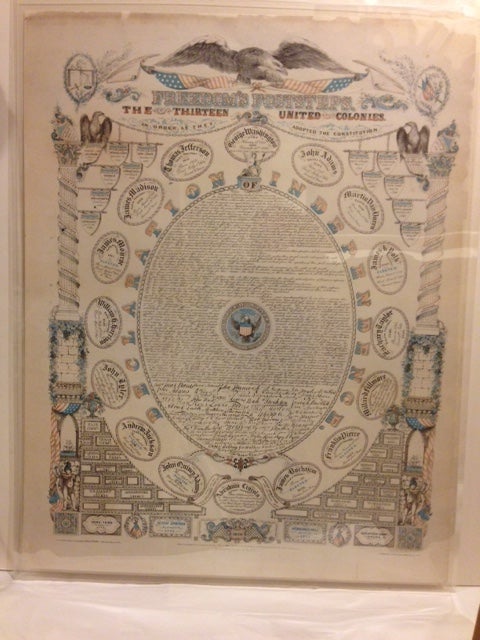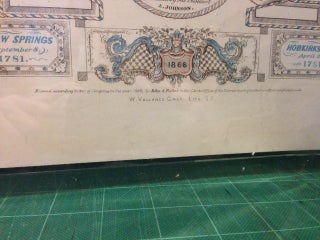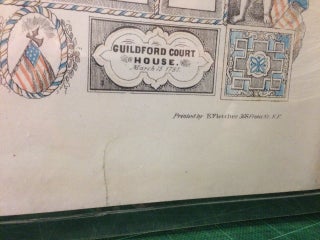FREEDOM'S FOOTSTEPS: THE THIRTEEN UNITED COLONIES.
Nevada County, Cal. Executed & published by John A. Fuller, W. Vallance Gray, Lith., Printed by E. Fletcher, 308 Front Street, 1866. Broadside, 66 x 51 cm., a multi-colored lithograph, printed in red, white and blue, containing the text of the Declaration of Independence. Described in detail upon its publication, in the "Sacramento Daily Union," [vol. 31. no. 4746], on 13 June 1866: "We have before us a beautiful illustration of this peculiarity of the State, in the production of John A. Fuller, a miner of Nevada, entitled ‘Freedom's Footsteps.’ During his leisure hours this gentleman designed and executed with the pen a large chart, emblematic of the progress of our country, the events by which independence of the nation was secured, the nature of the Union and the Industrial springs of its prosperity. In the center is a neatly written copy of the Declaration of Independence, with the signatures of the immortal fifty-six. The border is composed of Corinthian columns, twined with the memorials of the Revolution -- the Union being typified by the masonry of States at the base of each column. The names of the Presidents, from Washington to Lincoln, surround the oval center-piece containing the Declaration. Over all flies the national eagle, grasping the flag. The design evinces refined taste and intelligence, and the penmanship could not be easily surpassed by professors in that line. This chart has been elegantly lithographed by W. Vallance Gray, of San Francisco." OCLC locates one copy (Virginia, in the Albert Small “Declaration of Independence” collection). The broadside has several hairline cracks which slightly affect the image on the original, brittle paper and shallow chipping along the edges and at the corners, not affecting any text. It has been professionally backed with Japanese paper. A visually dramatic broadside from post-Civil War California. Item #59336
In the center of the text of the Declaration of Independence is a colorful example of the Seal of the United States. Down the columns on either side of the Declaration, and in bordered boxes below are some of the names of famous Revolutionary War battles, with their dates. Details regarding the Presidents have also been entered. Lincoln's assassination is noted, "at Ford's Theater Washington DC / succeeded by vice President / A. Johnson." Fuller makes a few very minor mistakes in his details. Death dates are not given for either John Tyler or Martin Van Buren, though both had died in 1862. The masonry bricks along the bottom edge of the broadside represent the states admitted to the Union, and their dates of admission are given, including California (1850). Fuller lists Minnesota's date as 1860, though it was actually admitted in 1858. West Virginia is present, but has no date. OCLC lists one previous work by the lithographer, W. Vallance Gray, a map of the gold and silver mining districts of the state of Nevada, published in 1865 [see: Graff: #1882.] Gray (1839-?), a native of Scotland, studied lithography there with the firm of McClure & McDonald. In 1860 he took a position with the Presbyterian Malay Missionary Society in Singapore and spent two years teaching lithography to the Malays. He then determined to travel around the world, but only got as far as San Francisco before settling down. He worked for Britton & Rey lithographers for one year, then joined the large publishing firm of A.L. Bancroft where he worked for a number of years. [See: "Sketches of Leading and Representative Men of San Francisco," by O.T. Shuck, published in 1875.] Gray also worked with C.B. Gifford in the late 1860's and 1870's, creating a number of views of California cities, including San Francisco and San Jose. Gifford's technique of "showing the city as seen looking west from an imaginary point in the air," was later adapted by many different artists to create other "bird's eye" city views. [see: Reps, "Views and Viewmakers of Urban America," p.178.].
Price: $17,500.00





